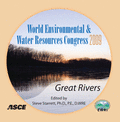A Methodology to Reconstruct Groundwater Contamination History with Limited Field Data
Publication: World Environmental and Water Resources Congress 2009: Great Rivers
Abstract
A health risk assessment of exposure to contaminants in drinking water frequently requires reconstructing the groundwater contamination history in aquifers. The development of groundwater flow and contaminant fate and transport models used in such an analysis is time-consuming and expensive. Therefore, new approaches need to be explored to reconstruct groundwater contamination history that may reduce the time and expense of the traditional numerical modeling approaches. An ongoing health study at U.S. Marine Corps Base Camp Lejeune, North Carolina, will determine if an association exists between exposure to contaminated drinking water and birth defects and childhood cancers in children born to women who were pregnant while living at the base during the period 1968–1985. For this study, there are no field data on groundwater contamination at water-supply wells prior to 1985. Limited contaminant concentration data at several observation wells are available during and after 1992 when remedial investigations of the contaminated aquifers began. To assist the epidemiological study in determining historical exposure scenarios, groundwater contaminant history needs to be reconstructed at base housing areas. Interpreting the mathematical models that are used in the analysis of groundwater flow and contaminant fate and transport and using the field data available on contaminant levels, a linear control model is proposed for the purpose of reconstructing the historical exposure to contaminated groundwater. The control model includes two matrices: (i) the first matrix describes the system behavior of the contaminant movement in aquifers in a natural environment and, (ii) the second matrix reflects the effect of pumping operations on contaminant concentrations. In the control model, the system matrix is recognized by using the least-squares method and the effect of pumping operations is determined by using an optimization method and an improved genetic algorithm when solving for matrix coefficients. To test the proposed methodology and to demonstrate the effectiveness of the model and proposed algorithm, the Tarawa Terrace base housing area of Camp Lejeune, which has been modeled in detail, is chosen. Computational results show that the model proposed herein can be used as a screening method to recover groundwater contamination history with reasonable accuracy considering the lack of data that may exist at many sites.
Get full access to this article
View all available purchase options and get full access to this chapter.
Information & Authors
Information
Published In
Copyright
© 2009 American Society of Civil Engineers.
History
Published online: Apr 26, 2012
ASCE Technical Topics:
- Contaminant transport
- Engineering fundamentals
- Environmental engineering
- Field tests
- Groundwater pollution
- History
- History and Heritage
- Hydrologic data
- Hydrologic engineering
- Hydrology
- Mathematical functions
- Mathematics
- Matrix (mathematics)
- Pollutants
- Pollution
- Practice and Profession
- Tests (by type)
- Water and water resources
- Water pollution
Authors
Metrics & Citations
Metrics
Citations
Download citation
If you have the appropriate software installed, you can download article citation data to the citation manager of your choice. Simply select your manager software from the list below and click Download.
